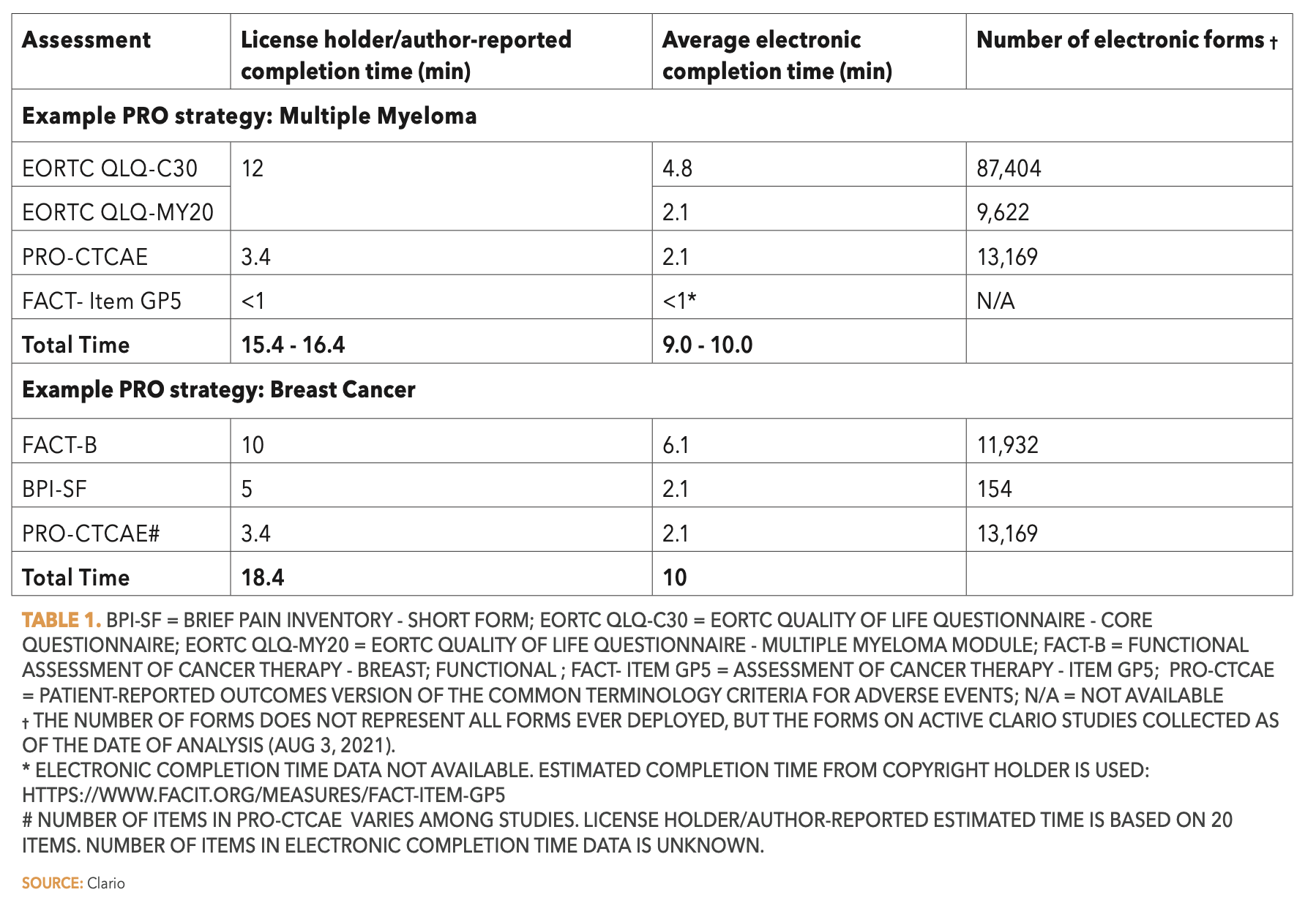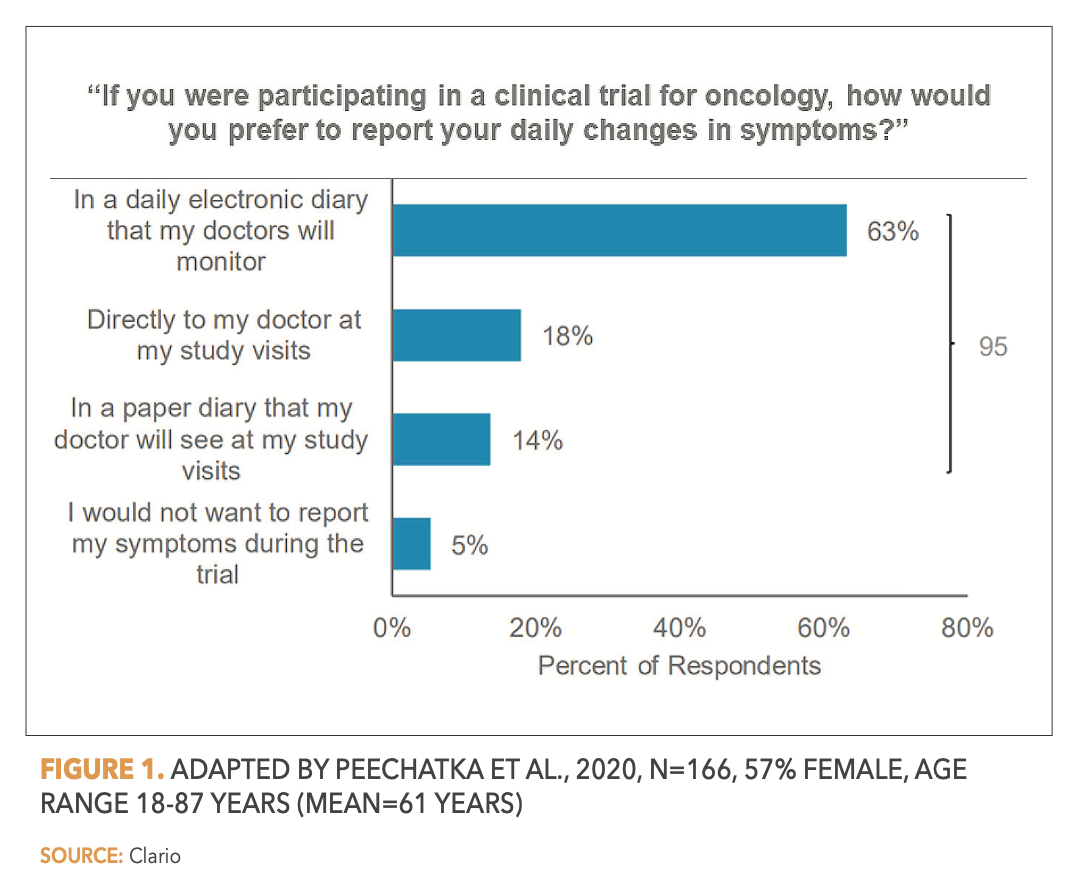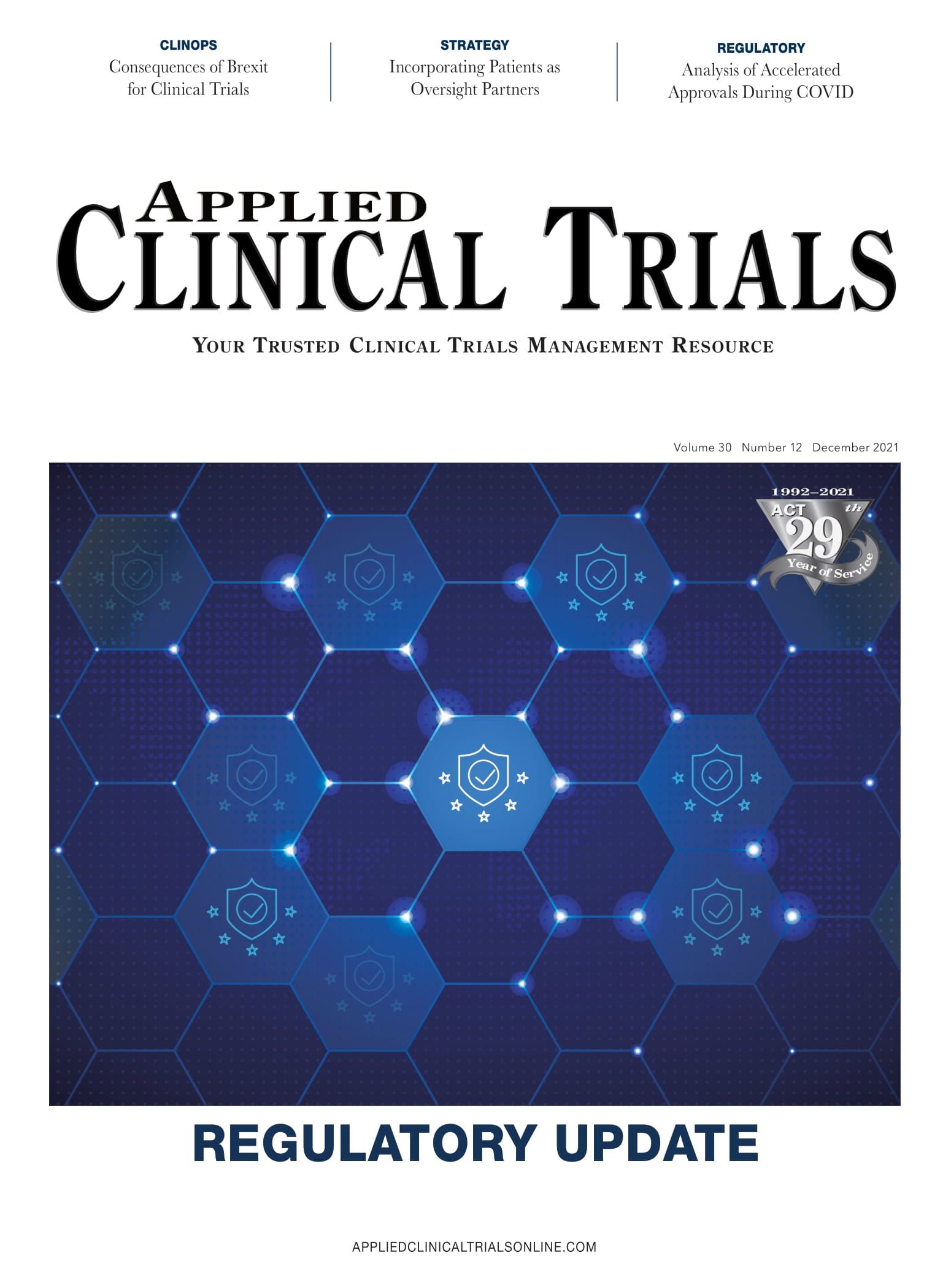Considering Patient Burden in Oncology
Implementing new strategies with the use of patient-reported outcomes.

It is no secret; we as an industry need to do better for our oncology patients as they embark on clinical trial journeys. How do we do better? We need to measure what is important to patients and make it as easy as possible for patients to participate in clinical trials.
When measuring what is important to patients, we need to look beyond traditional endpoints in order to get a more complete and accurate picture of treatment benefit for patients. In recent years, there has been growing expectation that indicators of clinical benefit beyond survival and tumor responses, such as a patient’s quality of life and disease symptoms, be measured and incorporated into the risk-benefit evaluation for cancer trials. These can be most effectively evaluated through the use of patient-reported outcome (PRO) measures, where information on the impact of disease and treatment is obtained directly from the patient. With mounting regulatory-driven patient-centered initiatives, such as the numerous programs of the FDA’s Oncology Center of Excellence (OCE), the new focus on PROs in oncology is not only to better evaluate drug efficacy, but to make sure that the patient’s voice is heard. Understanding what matters to patients during the course of their disease and treatment and creating thoughtful strategies on how to measure these concepts is imperative if we are to create drug development programs that are truly patient-focused.
The recent emphasis on patient-focused drug development continues in the oncology landscape with FDA’s new draft guidance for industry on “Core Patient-Reported Outcomes in Cancer Clinical Trials,” issued by the OCE, Center for Biologics Evaluation and Research (CBER), and Center for Drug Evaluation and Research (CDER).1 Although still in draft form, this guidance helps solidify years of FDA Clinical Outcome Assessment (COA) public workshops and literature best practices in PRO data collection in oncology. It provides industry guidance on how to best incorporate core PRO measurements into oncology clinical trials in efforts to correct the historical “heterogeneity in PRO assessment strategies [that] has lessened the regulatory utility of PRO data from cancer trials.” In addition to trial design and labelling considerations, the guidance recommends five core PRO concepts that should be collected in oncology clinical trials: 1) disease-related symptoms, 2) symptomatic adverse events, 3) overall side effect impact summary measure, 4) physical function, and 5) role function. While these core PROs include essential measures of symptoms and quality of life, it is important to note that measuring additional concepts that are important to patients outside of these core PROs may be warranted in order to truly measure what is important to patients (i.e., impact of cancer and treatment on their personal relationships, family, financial stability, etc.).
With this new draft guidance on core PROs in oncology, and with detailed guidance on how to incorporate the patient voice in drug development with CDER’s Patient-Focused Drug Development program,2 we are encouraged to determine what is important to oncology patients. In doing so, it is imperative that we keep the patient in mind not only when choosing which PRO measures to include, but also when deciding how they are implemented into the clinical trial strategy. One key area for consideration is patient burden. The life of a cancer clinical trial participant is not easy. Debilitating cancer symptoms, treatment side effects, long travel times to clinical trial sites, all in addition to their everyday responsibilities such as work, childcare, and household tasks, make life extra difficult for these patients. Therefore, while we may have a better picture of what PROs to collect in clinical trials, how do we make completing these PROs motivating instead of burdensome? What is the right balance between collecting a thorough picture of the patient’s symptoms, experiences, and quality of life, and not over-burdening patients with PROs?
First, let’s consider how long it takes patients to complete PROs. The FDA’s new draft Oncology PRO guidance specifically states that sponsors can collect additional PROs beyond the five core PROs identified, but that additional PROs should be “carefully considered to minimize patient burden and improve the quality of data collected by focusing on the most meaningful and measurable outcomes.” This is not to discourage the collection of additional measures that are important to the specific patient population being studied, but to emphasize that PRO selection should be thoughtfully considered.
Following the FDA’s new draft Oncology PRO guidance, we created an example PRO strategy for a study in multiple myeloma and a study in breast cancer and evaluated the time it would take to complete assessments in each example as shown in Table 1 below. The table does not represent the frequency of each PRO administration, but represents the amount of time it would take a patient to complete all study PROs. The new draft guidance encourages thoughtful consideration of assessment frequency, recommending more frequent assessments in the first weeks of treatment. Although each assessment frequency is unique and can be different depending on research objectives, our example is modeling the scenario of the highest patient burden where patients would complete all PROs at a single study visit (or at the same time). The second column in Table 1 shows the time it takes to complete each assessment according to the license holder and/or author’s website for that assessment (i.e., eProvide), which is usually based on paper administrations. The examples show an estimated time of completion around 16 minutes to complete all PROs in the Multiple Myeloma example and around 18 minutes to complete all PROs in the Breast Cancer example. We then explored the amount of time to complete these assessments when implemented electronically (ePRO). The third column shows the average time it takes to complete each assessment via Clario’s eCOA devices, with the number of administrations noted in Column 4. For both examples, the average time to complete is about 10 minutes.

While the advantages of ePRO in oncology clinical trials has been shown across numerous contexts (i.e., preferred and recommended by patients, reduces missing data, increases quality of life and survival3-7), our data extends these advantages by showing ePRO may also decrease patient burden by reducing time to complete assessments. In a recent PinkSheet publication, a medical officer in the FDA’s Division of Oncology 2 was cited as recommending capping assessment items and time spent completing assessments to 50 items and less than 10 total minutes per visit.8 With total time to complete assessments over 10 minutes according to copyright holder estimates, the reduced completion time using ePRO suggests electronic implementation may be an important method for reducing patient burden. Indeed, according to the FDA’s new draft Oncology PRO guidance, ePRO is stated as a method to decrease patient burden, with emphasis on how ePRO allows for assessments outside of the clinic. The ability of ePRO to support remote assessment can minimize time spent in transportation and during a visit to a clinic, and is increasingly being utilized to allow for decentralized or hybrid trials. Our data show that not only does ePRO have the potential to reduce patient burden by offering completion in a more convenient remote setting, but may also reduce the time it takes patients to complete assessments. The reasons for faster completion time using ePRO versus paper need to be further explored, but could include ePRO’s engaging interface or single-click page turning.
Although the time it takes to complete PROs may be minimal, due to busy lives or debilitating symptoms, 10 minutes of PRO completion may still be a lot to ask. Therefore, an additional step we can take to minimize patient burden related to PRO completion is providing training for patients on the importance of PROs. Content can include education on their role and responsibilities in the study, which PRO assessments they will complete, the importance of compliance, their valuable role in the trial, and what to expect in a clinical trial. Training not only ensures that patients understand the importance of reporting honestly and accurately, but helps them understand the valuable contribution they are making by participating. In appreciating their contribution during training, we align with many patients who have an intrinsic motivation to contribute meaningfully to science. Although not the only reason for participating, an altruistic desire to advance therapeutic options has been found to be a major motivator for patients in cancer clinical trials.9 It is important to let patients know we are listening and responding to their needs. By adding such elements to training, instead of seeing PRO assessments as burdensome, patients may see them as an important way to communicate their symptoms and experiences. Clinicians and other site staff can also benefit from training on the importance of PROs and how they will be utilized within the endpoint strategy of the clinical trial. Clinicians may traditionally put more emphasis on objective clinical trial endpoints, like imaging, which could undervalue the importance of PROs. Patients might notice such an attitude. Therefore, training is important for both patients and clinicians, and this importance was noted frequently by patient advocates and experts alike in this year’s 2021 FDA COAs in Cancer Clinical Trials Public Workshop.10
Finally, let’s consider further the fact that patients want to report on their symptoms. A long instrument is not necessarily burdensome if it helps the patient tell the story that matters to them. For example, oncology patients reported minimal response burden upon completing a large battery of PRO measures (176-180 items), with almost a third of patients indicating that more questions could have been asked.11 However, a portion of patients (22%) noticed questions that were repetitive or ones that were not relevant to their concerns, highlighting the importance of carefully selecting relevant and meaningful PROs. In a recent published data set, we found that almost all surveyed participants (95%) with a self-reported history of cancer would want to report their symptoms during a clinical trial, and most indicated that there would be significant benefit to them (“very much” or “quite a bit”) in doing so.12 With the term “symptoms” being used generally, this preference for symptom reporting likely includes symptoms of their disease and treatment (i.e., treatment side effects). Additionally, most respondents preferred a higher frequency of reporting (as symptoms occur or daily) versus a lower frequency (weekly), and there was a significant preference to report symptoms in an electronic diary versus either a paper diary or verbally to their doctor during study visits as shown in Figure 1 below. Although patient burden is often raised as a concern when including PRO measures in oncology trials, this data shows that patients feel there is benefit of reporting symptoms, and want to do so frequently. Further, the willingness of patients to frequently report their symptoms was shown in a recent publication reporting high compliance (91%) of weekly electronic PRO completion over a year-long period.13

So, how do we incorporate PRO assessments without increasing patient burden? Be thoughtful and targeted when developing a PRO strategy. Consider FDA’s five core PRO categories released in their new draft Oncology PRO Guidance, and align frequency of reporting with research objectives. Avoid repetitive questions, focus on the most meaningful and measurable outcomes, and consider whether the item content justifies extending the reporting time. In training both patients and site staff, genuinely recognize the value of learning from the patient experience. Use electronic implementation of PROs as a strategy for minimizing the time spent on completing assessments and to align with patient preference for electronic reporting. Finally, take the opportunity to explore content directed at measuring what matters most to patients.
References
- FDA Draft Guidance for Industry: Core Patient-Reported Outcomes in Cancer Clinical Trials. June 2021. https://www.fda.gov/regulatory-information/search-fda-guidance-documents/core-patient-reported-outcomes-cancer-clinical-trials
- FDA CDER Patient-Focused Drug Development. Aug 2021. https://www.fda.gov/drugs/development-approval-process-drugs/cder-patient-focused-drug-development
- Ring et al., 2008. A randomized study of electronic diary versus paper and pencil collection of patient-reported outcomes in patients with non-small cell lung cancer. Patient 1(2):105-113.
- Velikova et al., 1999. Automated collection of quality-of-life data: a comparison of paper and computer touch-screen questionnaires. J Clin Oncol, 17(3):998-1007.
- Mody et al., 2021. Electronic patient-reported outcomes monitoring during lung cancer chemotherapy: A nested cohort within the PRO-TECT pragmatic trial (AFT-39). Lung Cancer 162:1-8.
- Basch E, et al. 2016. Symptom monitoring with patient-reported outcomes during routine cancer treatment: A randomized controlled trial. J Clin Oncol.;34(6):557-65.
- Basch E, et al. 2017. Overall survival results of a trial assessing patient-reported outcomes for symptom monitoring during routine cancer treatment. JAMA, 318(2):197-198.
- Sutter, 2021. Patient-reported outcomes in pediatric cancer trails endorsed by US FDA Advisory Committee. Pink Sheet Informa Pharma Intelligence.
- Godskesen et al., 2015. Hope for a cure and altruism are the main motives behind participation in phase 3 clinical cancer trials. Eur J Cancer Care (Engl) 24(1):133-41.
- FDA Public Workshop: 6th Annual Clinical Outcome Assessment in Cancer Clinical Trials Workshop, July 21-23, 2021. https://www.fda.gov/news-events/fda-meetings-conferences-and-workshops/fda-public-workshop-6th-annual-clinical-outcome-assessment-cancer-clinical-trials-workshop-07212021
- Atkinson TM, Schwartz CE, Goldstein L, Garcia I, Storfer DF, Li Y, Zhang J, Bochner BH, Rapkin BD, 2019. Prceptions of response burden associated with completion of patient-reported outcome assessments in oncology. Value Health 22(2):225-230.
- Peechatka AL, Gerzon, M, Ly, JJ, Dallabrida SM, 2020. Oncology patient preferences in reporting on symptoms. Int J of Clinical Trials 7(1):11-17.
- Mody et al., 2021. Electronic patient-reported outcomes monitoring during lung cancer chemotherapy: A nested cohort within the PRO-TECT pragmatic trial (AFT-39). Lung Cancer 162:1-8.
Kelly Dumais, PhD, Senior Scientific Advisor, Clario and Stephen Raymond, PhD, Chief Scientist, Clario
